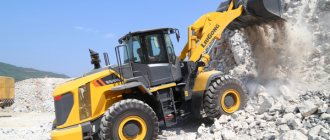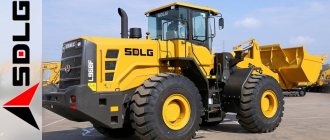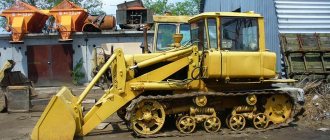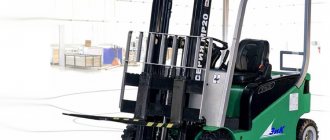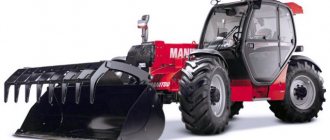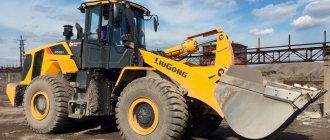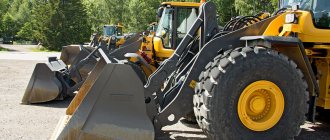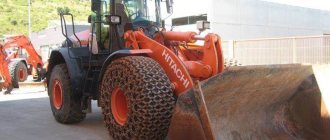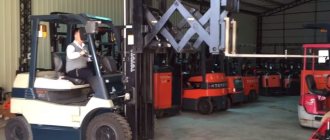The advantages of telescopic loaders is the topic of this material, which is relevant for many manufacturing industries, including petrochemical enterprises. To explore this topic, we talked with employees of one of the specialized companies.
The first telescopic boom loader was produced in 1977 by the British engineering company JCB (JC Bamford Excavators Ltd). The profitability of the machines was immediately appreciated, since they could replace several units of special equipment, so the use of telescopic loaders quickly spread in many economic sectors.
According to our interlocutors today, you can select and purchase such equipment on their specialized Machineryline site, where telescopic loaders from various manufacturers are presented, as well as detailed descriptions and technical characteristics of these machines.
Machineryline is a platform for the sale of industrial equipment and special equipment, which brings together sellers and buyers of equipment from different countries.
Further in the article we will look at what are the advantages of telescopic loaders over other loading equipment.
Device Features
Special equipment is equipped with additional elements that are mounted on a telescopic boom. This makes it possible to use the mechanism to perform different tasks.
The industry produces models that have different technical characteristics. When choosing a forklift, you need to pay attention to its load capacity, as well as the height of the load.
The fork-type mechanism is in demand by consumers, this is due to the fact that it is more universal. It is used for repairs, transportation of goods, and work in the agricultural industry.
Telescopic mechanisms are similar in appearance, but when choosing a model, enterprises must take into account the technical capabilities. Russia produces reliable telescopic loaders; foreign manufacturers also offer a wide range of models. Different mechanisms may have different characteristics; even if the general ones are the same, there will be a noticeable difference in the details.
Frame
Companies that produce forklifts equip them with the following types of frames:
- trough-shaped;
- side plates.
For the first type of arrow, thick metal is used. You can’t do without it, because the products are subject to heavy loads. The second type of frame differs in that the products are created from separate boxes. Their production requires significant financial investments.
Arrow
Equipment equipped with a telescopic boom has the following types of design:
- it extends with the help of chains;
- it moves thanks to hydraulic cylinders.
Chains stretch over time, so you will have to constantly monitor them. The cost of a chain mechanism is cheaper than a hydraulic one. Such models can be chosen by companies that rarely need a forklift. In other cases, it is better to choose a model whose operation is based on extending the boom using hydraulics. Such units are considered more reliable.
Transmission
On sale there is equipment with the following types of transmission:
- hydrodynamic;
- hydrostatic.
The hydrodynamic system is considered more reliable, so such loaders are suitable for performing a large volume of work.
The growing popularity of telehandlers
Previously, cargo transportation was carried out with the active use of backhoe loaders. However, the approach to cargo delivery has gradually changed, and now approximately 4 out of 5 items are delivered to their destination packed in cargo bags. This packaging shows high efficiency and ease of use. Therefore, telescopic loaders are widely used when transporting goods, including on construction sites.
Another important factor contributing to the success of these loaders on the market is versatility. Many models, but not all, have a device that allows you to quickly change equipment.
Multifunctional loaders can be equipped with the following tools:
- Bulldozer blade;
- Working platform;
- Forks for piece goods;
- Forks for agricultural work;
- Rake.
Compact telescopic lifts with a low boom were not known in America for just a few years. Only recently have they begun to be actively advertised and promoted on the market of agricultural machinery and warehouse equipment. Their design makes it possible to significantly increase the length of the boom.
Popular makes and models
Enterprises willingly purchase loaders produced by the following companies:
- Manitou;
- JCB;
- Gehl;
- MustangManufacturingCo;
- Sky Trak;
- Faresin.
This is a technique of French, English, American and Italian production. Manitou produces reliable units. The organization has a powerful production base and has established production of parts. The only drawback is the high cost of the products, so the units of this company on the Russian market belong to the most expensive segment.
JCB offers cheaper loaders, they are distinguished by good equipment. The organization supplies the market with a wide range of models; they are affordable.
The machines, which were produced by the Italian company Faresin, recently went on sale. They are of high quality. Many models copy Manitou equipment, but their cost is lower.
Enterprises operating in Russia buy equipment from Gehl, MustangManufacturingCo, and Sky Trak. The owner of the Mustang brand is the American company Gehl. It specializes in the production of telescopic loaders, offering consumers models of different load capacities.
This company owns the DL model. The unit is distinguished by the fact that it has the function of quick fixation of mounted implements. This allows you not only to attach a standard set of equipment to the loader, but also to equip the boom with a platform for lifting workers. Thanks to this, the model is in demand in the construction industry, when performing high-rise and installation work.
Gehl technology is different in that the client independently chooses the length of the telescopic boom based on his needs.
The company offers consumers a Caterpillar unit. It is equipped with a joystick, which makes it easier to control the machine. Many functions are automatic.
Frontal
Front loader is in demand in various industries. It is distinguished by functionality and reliability, its use allows you to increase labor productivity. The units have found application in agriculture and housing and communal services; they are used for loading and unloading in production and warehouses. The machines are used in construction and industry; they are indispensable in logging. The equipment can withstand heavy loads and has the following characteristics:
- high maneuverability;
- ability to withstand heavy loads;
- multifunctionality;
- good cross-country ability.
Various equipment can be attached to the unit, so one model can replace several machines. This allows the organization to save on the purchase of each of them.
Manufacturers equip units with telescopic booms with diesel engines; there are models with turbodiesel engines. They are highly economical and powerful. The machines have a long service life, so they will work for decades. Apart from changing the oil, they require virtually no other maintenance.
Most often, manual transmissions are installed on models, but units with automatic transmissions can also be purchased. If we talk about the transmission, it is hydrostatic or hydrodynamic. Thanks to these mechanisms, the speed of the machine can change instantly, and it is possible to quickly switch the travel mode back and forth.
While driving the car, the driver changes gears. Their number is the same in both directions. A joystick is used for control, but in some models it is replaced with handles. They are located on the steering column.
Manufacturers produce mechanisms on an articulated frame; they are characterized by high maneuverability.
This allows them to work in limited areas, for example, they are used in warehouses, for loading and unloading containers at docks. They are indispensable on livestock farms.
When choosing the latest electric forklifts, you need to consider engine power. It is important that the control system is convenient. The operator's cab must provide good visibility.
An organization may purchase a new rotating telehandler. The models are different, they have the following features:
- With only the front wheels turning.
- With all wheels turning. This is necessary so that they move along the track.
- With all wheels turning. The movement is carried out diagonally.
Turning is easy, because hydraulics are responsible for this. The driver will easily control even powerful cars.
The boom is fixed in the rear part of the body; it serves as a counterweight. This ensures the stability of the mechanism and makes work safe.
Crawler-mounted equipment is available for sale. It has a bucket, which allows it to be used in mountain quarries. Heavy Magni units have a rotating tower, with its help you can easily perform the required work in a small area.
Fork
Companies produce a wheeled forklift that is mounted on a four-wheel drive base. The unit is equipped with a 4-cylinder engine; it can run on gasoline or diesel fuel. Engine power - 75-130 hp. With.
The equipment has large wheels, which makes it possible to maneuver in confined spaces. Models are in demand in warehouses filled with cargo and goods. A forklift makes it easy to get work done on narrow city streets.
The units are equipped with an engine that generates energy and transmits it through a gearbox to the boom lifting mechanism. Devices designed to handle heavy loads have power units that complement the main ones.
When choosing a telescopic loader model, you need to remember that such equipment can work with a weight of no more than 5 tons. The maximum lifting height does not exceed 15 m. When choosing a mini loader for agriculture, you need to take this point into account.
JCB (UK)
This company occupies a significant position in the telehandler industry. Its main competitor, challenging leadership in this industry, is Manitou. JCB recently released details of the new JCB 515-40 telehandler, which is one of the smallest machines in its class. Its parameters:
- Lifting height 4 m;
- Nominal load capacity 2 t;
- Load capacity to maximum height 1.5 t.
This model is suitable for situations where a machine with a low lifting height is required and can operate on a minimum footprint. One of the areas of use of this technology is restoration work inside buildings. This machine has the following features:
- Minimum dimensions, smaller than conventional forklifts;
- All-wheel drive hydraulic suspension with rear steering wheels;
- Versatile use - as a forklift or as a 0.5 m3 loader.
However, this car has not yet been shown. Instead, the 535 HiViz telescopic lifts were presented, with the boom positioned low. The machines are characterized by the following advantages:
- Improved rear visibility, which was achieved by lowering the boom support joint down by 235 mm;
- Reducing the overall size of the boom section by 13%, the rear overhang by 90 mm and the turning radius by 300 mm;
- Side-mounted JCB Dieselmax 63 kW engine;
- New dashboard.
A more powerful model, equipped with a Tier III engine with a power of 74 kW, should appear at the end of the year.
Repair
The equipment is expensive, so repairs of telescopic loaders must be carried out by specialists from service centers. Diagnosis and repair work is carried out by qualified mechanics. Organizations cooperate with equipment manufacturers, so they have all the spare parts for telescopic loaders.
By following the operating rules and undergoing technical inspection on time, you can extend the service life of the units. Scheduled repairs prevent the occurrence of major breakdowns when not just one part, but components fail. The need for it is determined by diagnostics; during the inspection, the mechanic finds elements that require replacement.
Current repairs can be carried out on the territory of the owner of the equipment; the process of replacing damaged parts lasts from 2 hours to 3 days. This type of repair work is required when wear of the cuff is detected and there is a need to replace bushings and oil seals.
During a major overhaul, a complete disassembly of the device or one of its components is carried out. The technician determines the cause of the breakdown, assesses equipment wear, and installs new spare parts. Overhaul is required if ongoing repair work does not lead to a positive result. It takes about 1 month.
Manitou (France)
This company has already produced about 240 thousand forklifts, and considers itself a leader in this area. It owns approximately 26% of the market for this technology. Among the recently introduced machines is the MRT “Privilege” line, which includes loaders with a maximum working height of 18 – 25 m. These machines have been completely redesigned and are now equipped with Mercedes Euro III engines, which provide a 13% increase in net power. The operator's workplace has also been significantly improved. These machines use a modern cab design, which is characterized by greater spaciousness and improved visibility of mounted tools, which is ensured by a curved windshield.
Another important news regarding Manitou is the launch of the MRT 3050 into mass production. This machine has a lifting height of 30 m and a maximum lifting capacity of 5 tons. It was first presented at the Intermat exhibition last year. The machine has a telescopic boom with a pentagonal cross-section, which consists of five sections. The design of this unit provides significant rigidity, especially when in a horizontal position. This loader has three additional configuration options - with a winch, a working platform and a lifting platform. In the latter case, the work height can reach 40 m.
Merlo (Italy)
This company is famous for using advanced technologies in the creation of telescopic loaders. The release of a new product is taken very seriously. The Panoramic P 55.9 CS has a lift height of 8.6 m and a load capacity of 5.5 t. It has a new body design where the support joint is located very low, resulting in significantly increased rear visibility. The cab is equipped with hydropneumatic suspension, which ensures operator comfort.
Other important innovations in the car include:
- Merlo axles;
- Epicycloid reducers;
- Quiet four-cylinder Tier III 140 HP engine.
The company also released the Roto line of compact loaders. It contains improved versions of the K and KS machines, with a lifting capacity of up to 5 tons. The lifting height is limited to 16 m. These machines are produced with the idea that high lifting capacity is more important to customers than lifting height. The width of the new machines has been reduced by 50 mm and the length by 130 mm.
Haulotte (France)
Haulotte is new to this field. It currently has a line consisting of two machines: Top Lift HTL 4017 and HTL 4014. The first number in the designation indicates the lifting capacity in tons, and the second the lifting height in meters. Their advantage is significant stability. They have an advanced security system, which has additional audio and visual indicators, as well as a number of locking mechanisms. The control device is quite multifunctional and allows you to accurately perform movements of any complexity using only one hand.
Haulotte CEO Alexander Sobo said that the main goal in creating these forklifts was to ensure that the devices perform their functions under all conditions. The controls were made as simple and clear as possible so that the machine could be used by any operator who may violate the operating rules. Sobo noted that this year it will be possible to produce no more than 1,000 machines of this type. To make their production economically feasible, it is necessary to produce at least 3,000 loaders per year.
However, even considering how fiercely competitive the telehandler market is today, Haulotte is optimistic. It plans to secure about a tenth of the market, which corresponds to sales of approximately 5.5 thousand cars per year. The company's management has already spent considerable effort to enter the forklift market, and it is unclear when sales will increase. The use of the company's internal reserves had a negative impact on the production of new products. The development of car lifts may also be delayed due to difficulties with road regulations and engine requirements.
JLG (USA)
The company's alliance with Caterpillar for the production of loaders is developing extremely successfully. Production began last year in the fall, and customers were pleased with the quality of the machines manufactured at the JLG plant located in Belgium.
Next year it is planned to release a new generation of cars. The heads of the JLG-Cat alliance said that the task of the first year was the integration of machines. Once production of Cat machines has been established at JLG's facilities, the design of new models can begin.
JLG itself has released a modernized PS line, consisting of nine machines, onto the European market. Standard models have a powerful powershift transmission for increased towing capacity. The pump, which was load sensitive, is now connected to the compensation clan. The manufacturer claims that this solution has made the control more tractable and balanced, since the operating cycle of the hydraulic system began to take less time. Power efficiency has also increased, leading to overall increases in productivity and fuel economy.
The power shift transmission now has a fuel shut-off function using the brake pedal. If necessary, this function can be disabled. The interlocking system between the chassis and stabilizer has been improved. This allowed us to reduce the time of placement in the required position.
Liebherr (Germany)
The most important news from this company recently is the release of a new line of telehandlers. There are 4 models in the series, the load capacity is in the range of 3.5 - 4.5 tons, and the lifting height is 10 - 13 m. The line consists of the following machines:
- TL4 35/10;
- TL4 35/13;
- TL4 42/13;
- TL4 45/10.
Their feature is an oval arrow. However, this form was chosen taking into account the vast experience in the development of crane booms and is very technologically advanced. It has modest dimensions and a low hinge position, which provides excellent rear visibility.
Genie (USA)
The European line from this company has been replenished with another machine - GTH-6025R Giro. It is capable of full rotation and has a lift height of 24.8 m. The front reach is 20.9 m and the lifting capacity is 6 tons. The machine has four-wheel drive and is controlled by two handles, each of which provides four actions. The transmission is switched on the fly using a button.
In general, the machine is characterized by extensive use of electronics. It has the following specific devices:
- Maintenance indicator;
- A black box that records operating parameters;
- GPS module.
The drive is a four-cylinder Cummins engine with a power of 165 hp. with., having a turbo cooler.

